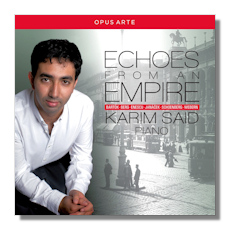
The Internet's Premier Classical Music Source
Related Links
-
Bartók Reviews
Berg Reviews
Enescu Reviews
Janaček Reviews
Schoenberg Reviews
Webern Reviews - Latest Reviews
- More Reviews
-
By Composer
-
Collections
DVD & Blu-ray
Books
Concert Reviews
Articles/Interviews
Software
Audio
Search Amazon
Recommended Links
Site News
 CD Review
CD Review
Echoes from an Empire

- Alban Berg: Piano Sonata, Op. 1
- Béla Bartók: Three Rondos on Slovak Folk Tunes, BB 92
- Leoš Janaček: Sonata 1 X.1905 "From the Street"
- Anton Webern: Sonata Movement (Rondo) for piano
- George Enescu: Suite #2 in D Major, Op. 10
- Arnold Schoenberg: Three Piano Pieces, Op. 11
Karim Said, piano
Opus Arte OACD9029D
There are really two empires referred to in the title of this first disc from the young Jordanian pianist Karim Said, now living and working in Berlin. The first is the Austro-Hungarian Empire, ruled from Vienna, that came to end in the First World War. The second is the empire of traditional harmony – also, in a sense, ruled from Vienna and also coming to the end of its life in the first decades of the twentieth century. The composers featured all originate from the Austro-Hungarian Empire and each is either actively promoting or in some sense reacting to the demise of musical certainties such as the major/minor harmonic system and traditional sonata form.
Of course, the comparison can only go so far. Unlike the Austro-Hungarian Empire, the major/minor harmonic system did not collapse. Very few of the pieces here would properly be described as atonal – probably only Schoenberg's Op. 11 Three Pieces, and even these are starting to sound surprisingly accessible, now that they are over a century old. But it is true that the major/minor harmonic system stopped being an organizing principle for most composers.
When one organizing principle disappears, composers reach for others. Folk song was a popular refuge, represented on this disc by Bartók's Three Rondos and also a strong presence in Janaček's Sonata. Neo-classicism was another option, illustrated here by Enescu's Suite #2, which features an ornate and charming Pavane. The third Schoenberg piece showcases the expressionism most famously developed in Erwartung (written in 1909, the same year as the Three Pieces, but not performed until 15 years later).
The best-known pieces here are most likely the Berg Sonata and Schoenberg's Three Pieces. The major discovery for me was the Enescu Suite. But the real reason to buy this collection is not any single performance, good though they are. This is one of those rare occasions when the whole is greater than the sum of its parts. This thematic recital tells a musical story. The story is a familiar one, famously told for example in Donald Mitchell's The Language of Modern Music 0812215435. But here it is told through an artful selection and juxtaposition of piano pieces. Very inventive and highly recommended.
Copyright © 2015, José Luis Bermúdez





















